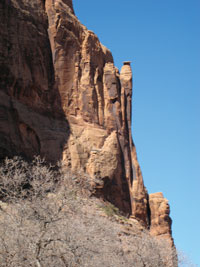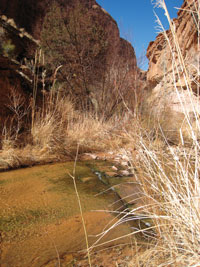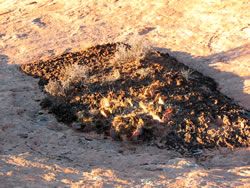HIKING HAPPENINGS
April 2009
Negro Bill Canyon – A Delightful Surprise
by Marcia Hafner
 The desert is filled with wonderful surprises–when you discover them it’s like getting up in the morning to find an unexpected bouquet of flowers on your kitchen table. The desert is filled with wonderful surprises–when you discover them it’s like getting up in the morning to find an unexpected bouquet of flowers on your kitchen table.
More than one surprise is tucked away in Negro Bill Canyon. This gem, with its gift of free-flowing spring-fed water, is just a few miles away from the busy streets of Moab. To get there take Highway 191 out of town for three miles and turn right on to Highway 128 (the river road). Then drive three more miles to the parking area on the right.
A perennial stream rushes through Negro Bill Canyon, a precious commodity in a parched habitat that begs for rain. Even in the dry years, it faithfully dances along all through the canyon. This everlasting source of water has created an oasis, a lush riparian growth zone of Fremont cottonwood, Gambel’s oak, water birch, tall reedy grass and coyote willow that is a magnet for wildlife. Beavers swim up canyon from the river and build their dams. Fish and crayfish, which look like miniature lobsters, show a particular fondness for the crystal depths of the pools. The bouncy down-the-scale song of the canyon wren is often heard cascading from its home on the canyon walls, while at the lower level rock wrens trill back and forth from one stony outpost to another. Closer to the creek, house finches, bushtits, ruby-crowned kinglets and spotted towhees prefer the protective shelter of thick vegetation.
This canyon is named after William Granstaff, an African-American prospector, who came to the Moab Valley in the spring of 1877. He grazed his cattle in the canyon and supposedly built a cabin in one of its side canyons. Accused of selling liquor to a tribe of Utes, an offense that outraged many settlers in the area, Granstaff found it expedient to move to Colorado in 1881 where he lived until his death in 1901.
At the mouth of the canyon the expansive Navajo Sandstone walls are coated with desert varnish, which looks like streaks of black-brown paint dumped over the top of the rim. This phenomenon usually happens where water drips down the canyon wall on to exposed, stable rock surfaces that are protected from frequent precipitation, fracturing or wind abrasion. The necessary ingredients for a desert varnish recipe are fine-grained clay and a host of bacteria and oxides –especially black manganese and red iron, which add the rich colors to the varnish. The gooiness of the clay holds the substances together allowing them to chemically react upon the sun-baked walls. None of this happens overnight –as many as 10,000 years may be required to complete the process.
 To walk your route through this riparian paradise, just follow the water that courses along next to the well-marked trail for two miles where another surprise is waiting – Morning Glory Natural Bridge. At 243 feet it’s the sixth longest span in the United States. The title is deceiving. It received its name not for any flower, but for the sunlight that hits it early in the morning. To walk your route through this riparian paradise, just follow the water that courses along next to the well-marked trail for two miles where another surprise is waiting – Morning Glory Natural Bridge. At 243 feet it’s the sixth longest span in the United States. The title is deceiving. It received its name not for any flower, but for the sunlight that hits it early in the morning.
The trail passes through the Negro Bill Wilderness Study Area, and that means no motorized or mechanical vehicles, including mountain bikes, are allowed. It begins with a sharp drop down to the left side of the stream. Then it crosses back and forth over the creek numerous times. The rushing sound of water as it gurgles over rocks and in and out of knee to waist deep pools is soothing. The crossings are not difficult when the water is low, and using a walking stick offers an extra third leg to make that leap from rock to rock easier. During the spring runoff it’s harder to keep your feet dry, but on a warm day getting wet is nothing to complain about. Pay close attention for the final crossing to the bridge. The sign can be overlooked because it is on the other side of the creek where the trail climbs up a side canyon and drainage before ending at the bridge.
At the bridge water flows down a crack and into a dark, secretive pool. Even from a short distance the bridge is not always readily apparent, and a walk into the deep shadows underneath it is necessary to appreciate the scale of its wide expanse.
Negro Bill Canyon has a lot to offer year round–a profusion of wildflowers in the spring, cool refreshment from the hot summer sun, idyllic Indian summer days ripe with the glorious colors of fall, and enormous columns of ice that feel like you’re walking through an ice palace. During the uncrowded times, it’s a quiet, magical place - a sanctuary that is filled with wonderful surprises. Be sure to get there early so you can enjoy that unquiet time of day. If you go in the winter, keep in mind walking on the ice can be very treacherous
A note of caution: Watch out for poison ivy, especially along the pool under the bridge. Don’t forget that the oil can be carried on the fur of dogs, which consequently can be transferred to your skin. This plant is a woody vine that grows throughout North America and can be identified by its characteristic cluster of three shiny leaves with few or no teeth, which turn a bright red in the fall. It has no thorns and produces grayish white berries.
|
Biological Soil Crust (aka)
Cryptos (krip’ tose):
The surface of
Moab’s desert is held
together by a thin skin of living organisms known as cryptobiotic
soil or cryptos. It has a lumpy black appearance, is very
fragile, and takes decades to heal when it has been damaged.
This soil is a critical part of the survival of the desert.
The cryptobiotic organisms help to stabilize the soil, hold
moisture, and provide protection for germination of the seeds
of other plants. Without it the dry areas of the west would
be much different. Although some disturbance is normal and
helps the soil to capture moisture, excessive disturbance
by hooves, bicycle tires and hiking boots has been shown
to destroy the cryptobiotic organisms and their contribution
to the soil. When you walk around Moab avoid crushing the
cryptos. Stay on trails, walk in washes, hop from stone to
stone. Whatever it takes, don’t crunch the cryptos
unless you absolutely have to! |

Cryptobiotic soil garden
|
|
|

 To walk your route through this riparian paradise, just follow the water that courses along next to the well-marked trail for two miles where another surprise is waiting – Morning Glory Natural Bridge. At 243 feet it’s the sixth longest span in the United States. The title is deceiving. It received its name not for any flower, but for the sunlight that hits it early in the morning.
To walk your route through this riparian paradise, just follow the water that courses along next to the well-marked trail for two miles where another surprise is waiting – Morning Glory Natural Bridge. At 243 feet it’s the sixth longest span in the United States. The title is deceiving. It received its name not for any flower, but for the sunlight that hits it early in the morning.